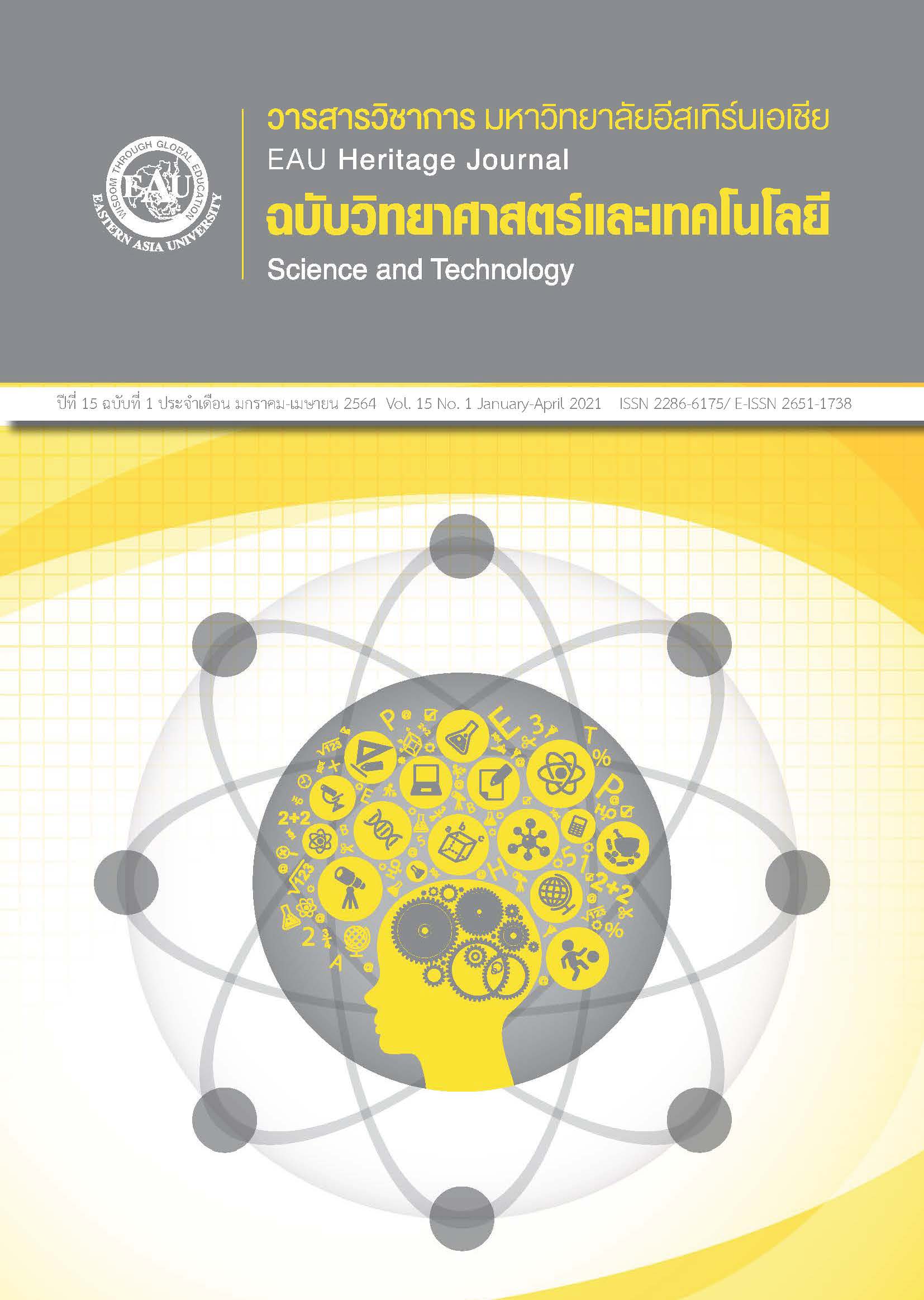การเกิดไฮดรอกซีอปาไทท์บนฟิล์มบางเซอร์โคเนียมไดออกไซด์ที่เคลือบบนสเตนเลสสตีล
คำสำคัญ:
ฟิล์มบางเซอร์โคเนียมไดออกไซด์, สปัตเตอริง, ไฮดรอกซีอปาไทท์บทคัดย่อ
การวิจัยครั้งนี้เป็นการเตรียมฟิล์มบางเซอร์โคเนียมไดออกไซด์ที่เคลือบบนสเตนเลสสตีล เกรด 316L ด้วยวิธีดีซี อันบาลานซ์ แมกนีตรอน สปัตเตอริง โดยปรับเปลี่ยนอัตราส่วนการไหลของแก๊สอาร์กอนต่อออกซิเจนเท่ากับ 1:2 1:4 และ 0.5:4 และทดสอบการเกิดสารประกอบไฮดรอกซีอปาไทท์บนฟิล์มบางเซอร์โคเนียมไดออกไซด์ที่เตรียมจากสภาวะต่าง ๆ กันด้วยการแช่ในสารละลาย Simulated Body Fluid เป็นเวลา 7 วัน แล้ววิเคราะห์คุณลักษณะของฟิล์มบางเซอร์โคเนียมไดออกไซด์และสารประกอบไฮดรอกซีอปาไทท์ที่เกิดขึ้นด้วยเทคนิคต่าง ๆ ได้แก่ การถ่ายภาพจากกล้องจุลทรรศน์อิเล็กตรอนแบบส่องกราด (Scanning Electron Microscope--SEM) ศึกษาธาตุองค์ประกอบด้วยเทคนิคการวิเคราะห์รังสีเอ็กซ์แบบกระจายพลังงาน (Energy Dispersive X-Ray Spectroscopy--EDX) และวิเคราะห์ผลึกด้วยเทคนิคการเลี้ยวเบนของรังสีเอ็กซ์ (X-Ray Diffraction--XRD) ผลการศึกษา พบว่า ฟิล์มบางเซอร์โคเนียมไดออกไซด์ที่ได้มีการจัดเรียงโครงสร้างผลึกเป็นเฟสโมโนคลินิกและเฟสเตตระโกนอล ซึ่งการใช้แก๊สออกซิเจนในสัดส่วนที่สูงขึ้นทำให้ความเป็นผลึกของเซอร์โคเนียมไดออกไซด์ลดลงและมีขนาดผลึกใหญ่ขึ้นด้วย และเมื่อทดสอบการเกิดสารประกอบไฮดรอกซีอปาไทท์พบว่า ฟิล์มบางเซอร์โคเนียมไดออกไซด์ที่มีขนาดผลึกเล็กที่สุดซึ่งเตรียมด้วยอัตราส่วนการไหลของแก๊สอาร์กอนต่อออกซิเจนเท่ากับ 1:2 สามารถเหนี่ยวนำให้เกิดสารประกอบไฮดรอกซีอปาไทท์ได้ดีที่สุดเนื่องจากมีพื้นที่ผิวสูงทำให้มีตำแหน่งกัมมันต์สำหรับก่อนิวเคลียสจำนวนมาก และมีอัตราส่วนแคลเซียมต่อฟอสฟอรัสใกล้เคียงค่าทางทฤษฎีมากที่สุด แสดงถึงสารประกอบไฮดรอกซีอปาไทท์ที่ได้มีความสมบูรณ์มากที่สุดเมื่อเทียบกับสภาวะอื่น
เอกสารอ้างอิง
Balestra, R. M., Ribeiro, A. A., de Oliveira, J. C., Cavaleiro, A., & Oliveira, M. V. (2014). Titanium substrate surfaces coated with hydroxyapatite by magnetron sputtering. Materials Science Forum, 798–799, 472–477. https://doi.org/10.4028/www.scientific.net/msf.798-799.472
Bollino, F., Armenia, E., & Tranquillo, E. (2017). Zirconia/hydroxyapatite composites synthesized via sol-gel: Influence of hydroxyapatite content and heating on their biological properties. Materials (Basel, Switzerland), 10(7), 757. https://doi.org/10.3390/ma10070757
Cataoru, M., Bollino, F., Tranquillo, E. Tuffi, R., Dell’Era, A., & Vecchio Ciprioti, S. (2019). Morphological and thermal characterization of zirconia/hydroxyapatite composites prepared via Sol-gel for biomedical applications. Ceramics International, 45(2), 2835-2845. https://doi.org/10.1016/j.ceramint.2018.07.292.
Chaiyakun, S., Witit-anun, N., Sriyanaluk, S., & Tavorntira, J. (1998). A study of the proper state for material coating by sputtering method (Research report). Chon Buri: Burapha University. (in Thai)
Cullity, B. D. (1978). Elements of X-Ray diffraction. Phillippines: Addison-Wesley Publishing.
Hanawa, T. (2004). Metal ion release from metal implants. Materials Science and Engineering: C, 24(6-8), 745-752. https://doi.org/10.1016/j.msec.2004.08.018.
Kokubo, T. (1998). Apatite formation on surfaces of ceramics, metals, and polymers in body environment. Acta Materialia, 46(7), 2519-2527. https://doi.org/10.1016/S1359-6454(98)80036-0.
Kokubo, T., & Takadama, H. (2006). How useful is SBF in predicting in vivo bone bioactivity. Biomaterials, 27(15), 2907-2915. https://doi.org/10.1016/j.biomaterials.2006.01.017.
Komlev, V. S., & Barinov, S. M. (2006). Novel bioactive hydroxyapatite-base ceramic and gelatin-impregnated composites. In B. M. Caruta, (Ed.), Ceramics and Composite Materials: New Research (pp. 133-146). New York: Nova Science Publishers.
Likitwanichkool, S. (1998). Ceramics for medical profession. Retrieved from http://lib3.dss.go.th/fulltext/dss_j/2541_46_148_p3-6.pdf
Lim, K. F., Muchtar, A., Mustaffa, R., & Tan, C. Y. (2014). Synthesis and characterization of hydroxyapatite-zirconia composites for dental applications. Asian Journal of Scientific Research, 7(4), 609-615. doi: 10.3923/ajsr.2014.609.615
Lluch, A. V., Ferrer, G. G., & Pradas, M. M. (2009). Surface modification of P(EMA-co-HEA)/SiO2 nanohybrids for faster hydroxyapatite deposition in simulated body fluid?. Colloids and surfaces. B, Biointerfaces, 70(2), 218–225. https://doi.org/10.1016/j.colsurfb.2008.12.027
Ma, C., Lapostolle, F., Briois, P., & Zhang, Q.Y. (2007). Effect of O2 gas partial pressure on structures and dielectric characteristics of RF sputtered ZrO2 thin films. Applied Surface Science, 253(21), 8718-8724. https://doi.org/10.1016/j.apsusc.2007.04.054.
Nagarajan, S., & Rajendran, N. (2009). Sol-gel derived porous zirconium dioxide coated on 316L SS for orthopedic applications. Journal of Sol-Gel Science and Technology, 52, 188-196. https://doi.org/10.1007/s10971-009-2024-0
Ruksudjarit, A. (2008). Fabrication of dense hydroxyapatite nanomaterials for bone implant applications (Doctoral dissertation). Ching Mai University. Ching Mai. (in Thai)
Sabree, I. K., & Mahdi, O. S. (2018). Characterization of zirconia-hydroxyapatite nanocomposites for orthopedic and dental applications. International Journal of Engineering and Technology, 7(4.19), 926-930. doi: 10.14419/ijet.v7i4.19.28072
Thaveedeetrakul, A., Boonamnuayvitaya, V., & Witit-anun, N. (2012a). Apatite deposition on ZrO2 thin films by DC unbalanced magnetron sputtering. Advances in Materials Physics and Chemistry, 2(4), 45-48. doi: 10.4236/ampc.2012.24B013
Thaveedeetrakul, A. Witit-anun, N., & Boonamnuayvitaya, V. (2012b). The role of target-to-substrate distance on the DC magnetron sputtered zirconia thin film’s bioactivity. Applied Surface Science, 258(7), 2612-2619. https://doi.org/10.1016/j.apsusc.2011.10.104.
Thaveedeetrakul, A., Witit-anun, N., & Boonamnuayvitaya, V. (2013). Effect of sputtering power on in vitro bioactivity of zirconia thin films obtained by DC unbalanced magnetron sputtering. Journal of Chemical Engineering of Japan, 46(1), 79-86. doi: 10.1252/jcej.12we088
Uchida, M., Kim, H.‐M., Kokubo, T., Miyaji, F., & Nakamura, T. (2001), Bonelike apatite formation induced on Zirconia Gel in a simulated body fluid and Its modified solutions. Journal of the American Ceramic Society, 84, 2041-2044. https://doi.org/10.1111/j.1151-2916.2001.tb00955.x
Uchida, M., Kim, H.-M., Kokubo, T., Tanaka, K., & Nakamura, T. (2002a). Structural dependence of apatite formation on Zirconia Gels in a simulated body fluid. Journal of the Ceramic Society of Japan, 110(1284), 710-715. https://doi.org/10.2109/jcersj.110.710
Uchida, M., Kim, H. M., Miyaji, F., Kokubo, T., & Nakamura, T. (2002b). Apatite formation on zirconium metal treated with aqueous NaOH. Biomaterials, 23(1), 313-317. doi: 10.1016/s0142-9612(01)00110-7.
Ureña, J., Tsipas, S., Jiménez-Morales, A., Gordo, E., Detsch, R., Bocaaccini, A. R. (2018). In-vitro study of the bioactivity and cytotoxicity response of Ti surfaces modified by Nb and Mo diffusion treatments. Surface and Coatings Technology, 335, 148-158. https://doi.org/10.1016/j.surfcoat.2017.12.009.
Wikipedia, The free encyclopedia. (2020). Sputter deposition. Retrieved from https://en.wikipedia.org/wiki/Sputter_deposition.
Witit-anun, N., Kasemanankul, P., Chaiyakun, S., & Limsuwan, P. (2009). Structures and optical properties of TiO2 thin films deposited on unheated substrate by DC reactive magnetron sputtering. Kasetsart Journal (Natural Science), 43, 340-346. (in Thai)
Yan, Y., Han, Y., & Lu, C. (2008). The effect of chemical treatment on apatite-forming ability of the macroporous zirconia films formed by micro-arc oxidation. Applied Surface Science, 254(15), 4833-4839. https://doi.org/10.1016/j.apsusc.2008.01.117.







